
* The German Arado 234 was the very first purpose-built jet bomber. While the Ar 234 had very little influence on the outcome of World War II, being much too late and too few in number, it had influence on later aircraft designs. This document provides a history and description of the Ar 234, as well as the experimental German Heinkel He 343 and Junkers Ju 287 jet bombers.
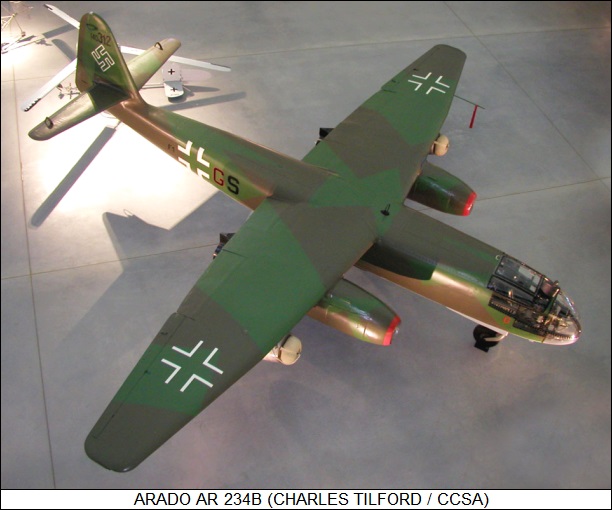
* The Ar 234 was originally conceived in early 1941 by an engineering team under Professor Walter Blume, director of the Arado aircraft company. The design project was codenamed "E370", and was in response to a German Air Ministry requirement for a fast reconnaissance aircraft. The E370 was to be a sleek, high-winged aircraft powered by a pair of Junkers Jumo 004 turbojets, one under each wing. The Air Ministry wanted a range of 2,150 kilometers (1,340 miles), and so to reduce weight, Arado proposed that the E370 would take off on a wheeled tricycle trolley that would be dropped by parachute once the aircraft took to the air; the machine would land on skids at the end of the flight. Skids would also be built under the engines to protect them from damage. The pilot would be able to steer the nosewheel of the take-off trolley, while the main wheels would have hydraulic brakes, controlled by the cockpit rudder pedals.
Arado projected a maximum speed of 780 KPH (485 MPH), an operating altitude of almost 11,000 meters (36,000 feet), and a maximum range of 2,000 kilometers (1,250 miles). The range was a little less than what the Air Ministry wanted, but they liked the design anyway and ordered two prototypes. The aircraft was given the service designation of "Ar 234". Additional prototypes would be ordered later.
The two initial prototypes, designated "Ar 234 V1" and "Ar 234 V2", where "V" stood for "Versuchs (prototype)", were largely complete before the end of 1941. However, the Jumo 004 engines weren't ready, and wouldn't be ready for over a year. In February 1943, Arado finally got a pair of Jumo 004As, though these engines were only cleared for static and taxi tests. At the time, Messerschmitt had priority for engine deliveries for their Me 262 fighter, and Arado had to accept what they could get.
* Flight-qualified engines were finally delivered late that spring, and the Ar 234 V1 made its first flight on 30 July 1943. The initial flights went smoothly, except that on the first two take-offs the take-off trolley parachutes didn't deploy, and the trolley was wrecked in both cases.
By September, four prototypes were flying. However, back in early July, even before the first flight, the Air Ministry had been seriously considering building a bomber version of the Ar 234. Orders were placed for two prototypes of such a bomber variant, with the designation "Ar 234B" and the name of "Blitz (Lightning)". Since the aircraft was too slender to carry the bombs internally, the bombs would have to be carried on external racks. It would also have conventional tricycle landing gear, since the skid landing scheme had proven conceptually flawed. Skid landings were a rough and doubtful proposition, and once an Ar 234 had landed, it was effectively immobile for the twenty minutes it took to jack it up and put it back on its trolley. With Allied air attacks increasing over the Germany, skid landing made the aircraft far too vulnerable to destruction on the ground.
* The Ar 234 program suffered a tragic setback when the Ar 234 V2 crashed due to an engine failure on 2 October 1943, killing the pilot. Nonetheless, Adolf Hitler and other top-ranking Nazis saw a prototype on static display at an airshow in East Prussia in late November and were very impressed. The program was given the highest priority.
Work intensified on a prototype of the Ar 234B variant, while four more trolley-mounted Ar 234 prototypes were completed. The fifth prototype, the "Ar 234 V5", incorporated new Jumo 004B-0 preproduction engines, which had the same thrust rating of 8.2 kN (840 kgp / 1,850 lbf) as the Jumo 004A prototype engines used in the first four Ar 234 prototypes, but weighed 90 kilograms (200 pounds) less. The seventh prototype, the "Ar 234 V7", was similar to the Ar 234 V5.
The sixth and eighth prototypes, the "Ar 234 V6" and "Ar 234 V8" respectively, were intended to study powerplant schemes to be used on advanced versions of the Ar 234. They were both powered by four 7.85 kN (800 kgp / 1,760 lbf) thrust BMW 003 turbojets. The BMW 003 had less thrust than the Jumo 004B, but the BMW engines were much lighter, and increased the overall thrust-to-weight ratio of the aircraft.

The sixth prototype had the four BMW engines in separate nacelles, while the eighth prototype clustered them in pairs under each wing. The paired nacelle scheme proved more satisfactory than the four separate nacelles, which had led to aerodynamic troubles.
All the prototypes starting with the third had provision for "Rauchergeraet", or rocket-assisted take-off boosters. A rack was fitted under each outer wing to carry a bottle-shaped Walter 109-500 rocket, powered by hydrogen peroxide and sodium permanganate catalyst that turned the hydrogen peroxide into steam. Each rocket weighed about 280 kilograms (617 pounds), and was capable of generating 4.9 kN (500 kgp / 1,100 lbf) thrust for 30 seconds. The rockets were dropped by parachute after the Ar 234 was airborne. The aircraft incorporated a scheme of pressure switches that sensed whether the rocket units were delivering thrust or not; if one did not generate thrust, the other was automatically shut down, to prevent it from slewing the aircraft around.
The ninth prototype, designated "Ar 234 V9" or "Ar 234B-0", was the first Ar 234B, with a built-in undercarriage, and first flew on 10 March 1944. By this time, production lines were being set up to build the aircraft in quantity, and the first of 20 pre-production Ar 234Bs came off the line in June. However, ambitious plans for massive production of new variants had to be scaled back. During the last week of February 1944, the Allies pounded German aircraft factories and seriously damaged production capacity. While the "Big Week" raids had spared Arado production facilities, since they were too far east and out of range, the following reshuffling and dispersal of production meant that resources originally planned for building new types of aircraft had to be reserved for manufacturing existing types.
* That same March, the fifth and seventh prototypes were equipped with cameras and handed off to a special Luftwaffe reconnaissance unit for operational readiness tests, in preparation to fielding the Ar 234B. The Allied invasion of France then gave the aircraft an excellent opportunity to prove themselves. Allied fighters were doing such a good job of protecting the Normandy beachhead from German reconnaissance aircraft that Wehrmacht commanders were completely in the dark about enemy intentions.
The Ar 234, with its high speed, seemed likely to penetrate Allied fighter screens, and on 25 July the two aircraft left Germany for France. One had to turn back, but the other arrived safely, only to wait a week for the take-off trolley, rocket booster units, and other kit to arrive by truck. The first operational flight took place on 2 August 1944, when Leutnant Erich Sommer took his Ar 234 on a reconnaissance flight over the beachhead, cruising at about 740 KPH (460 MPH) at above 9,200 meters (30,000 feet). Two Rb 50/30 aerial cameras were mounted in the rear fuselage, each canted 12 degrees from the vertical in opposite directions. At operating altitude, they took one set of pictures every 11 seconds, imaging a swath almost 10 kilometers (6 miles) wide across the direction of flight.
Sommer came and went unhindered. Altitude and speed kept him safe, and in fact he wasn't even detected. The images he returned showed a buildup of more than 1.5 million men, along with a matching amount of supplies and weapons. That day the second Ar 234 finally arrived, and over the next three weeks the two machines flew 13 more missions without interference from Allied defenses. They returned high-quality intelligence data, but they only confirmed in detail what the Wehrmacht ground commanders knew only too well: the Germans were being beaten by an overwhelmingly superior adversary.
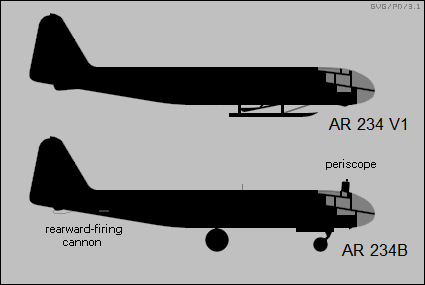
The results of this became apparent to the jet pilots, when they were forced to withdraw to the Netherlands in early September. This did not take them out of harm's way; their airfield at Volkel was plastered by 100 Royal Air Force (RAF) Lancasters in a daylight raid on 3 September 1944. The Ar 234s were then withdrawn back to Germany. By this time, Ar 234Bs were available for operational use, and the prototypes were no longer needed for front-line service.
BACK_TO_TOP* A stock Ar 234B could be configured either as a bomber or reconnaissance aircraft. Maximum bomb load was about 1.5 tonnes (3,300 pounds), carried externally. A typical bomb load was a single 500-kilogram (1,100-pound) bomb under the fuselage centerline and under each engine nacelle; but a single 1,000-kilogram (2,000-pound) bomb or 1,400-kilogram (3,080-pound) bomb could be carried on the centerline as an alternative bombload. When used as a reconnaissance aircraft, the Ar 234B carried a 300-liter (79 US gallon) drop tank under each engine in place of the bombs.
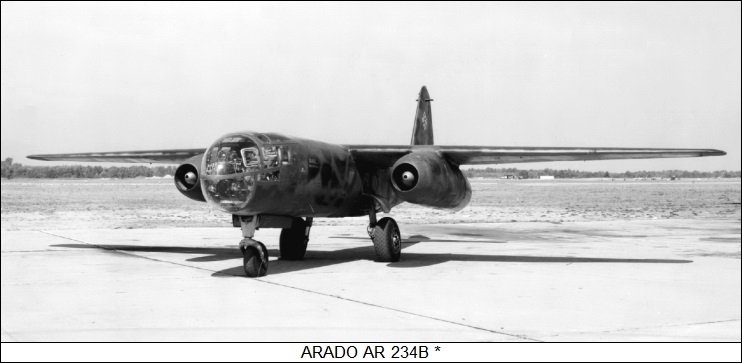
The powerplants consisted of a pair of full-production Junkers Jumo 004B turbojets, with 8.83 kN (900 kgp / 1,980 lbf) thrust each. Maximum speed without bombs or drop tanks was 740 KPH (460 MPH) at 6,100 meters (20,000 feet), but the speed dropped to as low as 660 KPH (410 MPH) with external loads. The prototypes had actually been a good 30 KPH (19 MPH) faster than the Ar 234B, since the lack of landing gear made them lighter and more streamlined.
_______________________________________________________________________
ARADO AR-234B:
_______________________________________________________________________
wingspan:
14.1 meters (46 feet 4 inches)
wing area:
26.4 sq_meters (284.16 sq_feet)
length:
12.6 meters (41 feet 6 inches)
height:
4.30 meters (14 feet 1 inch)
empty weight:
5,200 kilograms (11,464 pounds)
MTO weight:
9,850 kilograms (21,715 pounds)
maximum speed:
740 KPH (460 MPH / 400 KT)
service ceiling:
10,000 meters (32,810 feet)
operational radius:
800 kilometers (500 MI / 435 NMI)
_______________________________________________________________________
Tricycle landing gear was fitted, with single wheels on all assemblies, and low-pressure tires for rough-field operation. The nose gear retracted backwards, while the main gear retracted inward and forward into the sides of the fuselage.
Since the Ar 234 landed at high speed, it had a drag chute as standard equipment; it was one of the first aircraft built with such a feature. The rounded nose of the aircraft was covered with plexiglas, giving the pilot an excellent view to the front, but no view to the back except through a periscope. The periscope, which was not fitted to the Ar 234 prototypes, also served as a sight for dive-bombing attacks. Although an ejection seat had been fitted to some of the prototypes, the Ar 234B did not have such a nicety: the pilot got into and out of the aircraft through a transparent hatch on top of the cockpit. Getting out of the Ar 234 in an emergency was not all that easy.
The Ar 234 handled very well at all speeds, and was capable of all aerobatics. The worst operational problem was the unreliability of the Jumo 004B engines, which required overhaul or replacement after as little as ten hours of operation. The brakes also tended to wear out after about three landings, and so had to often be replaced. The fuel consumption of the Jumos varied widely with altitude: at 10,000 meters (33,000 feet), it was a third of what it was at sea level. That meant that for low-altitude bombing missions, the operational radius of the aircraft was only about 190 kilometers (120 miles), while in high-altitude reconnaissance operations, the range was as much as 720 kilometers (450 miles) with drop tanks.
When operated as a bomber, the Ar 234 could be used in shallow dive attacks, low-level horizontal attacks, or high-altitude horizontal attacks. In shallow dive attacks, the pilot would drop from about 5,000 meters to under 1,500 meters (16,400 to 4,920 feet) height, aiming the bombs through the periscopic sight that stuck up above the cockpit. In low-level horizontal attack, used only when the target was obscured, the pilot simply flew level and dropped the bombs when it seemed appropriate; results were generally unimpressive.
High-altitude horizontal attacks were particularly interesting. Since the Ar 234 was a single-seat aircraft, the pilot had to double as the bombardier, and did so with the help of a sophisticated Patin autopilot system. The pilot would fly to within about 30 kilometers (19 miles) of the target, engage the autopilot, swivel the control column out of his way to the right, and then lean over and sight the target through the Lotfe 7K bombsight. The bombsight was linked to the autopilot. As long as the pilot held the target in the crosshairs, the autopilot would change the aircraft's heading accordingly, and then the bombsight would automatically drop the bombs at the right moment.
In principle, the Ar 234B had a pair of fixed rearward-firing 20-millimeter MG-151/20 cannon for protecting its tail, with the pilot sighting the guns through the periscope. Not only did the pilot have to be his own bombardier, he was his own tail gunner as well. However, the scheme was clumsy and if a pilot saw an Allied fighter behind him, he could just put on speed to lose it, dumping his external load if necessary. In practice, the guns were not always fitted, and were never an important feature of the aircraft. Armor plate was attached to the rear wall of the cockpit to give the pilot a little protection.
* The Luftwaffe conducted reconnaissance operations with the new Ar 234Bs through the fall, including some missions over England, beginning in October, to determine if the Allies were preparing a follow-up amphibious landing in the Netherlands. Despite the activity, it wasn't until 21 November 1944 that Allied pilots reported spotting an Ar 234B, when P-51s escorting bombers over the Netherlands observed one of the jets overflying their formation. Detected, the German pilot immediately applied power and disappeared.
Bomber sorties did not take place until Christmas Eve, when nine Ar 234Bs, each carrying a single 500-kilogram (1,100-pound) bomb, took off from a German airbase single file to attack Liege in Belgium, in support of the Wehrmacht's ground offensive then underway in the Ardennes. Such attacks continued until early January, when the weather became too foul to allow flight operations to be safely continued.
An inventory of Ar 234s at that time indicated 17 in service, with 12 configured as bombers and 5 as photo-reconnaissance machines. This quantity was surprisingly small, since 148 had been delivered to the Luftwaffe by the end of 1944. The small number of the aircraft in service was almost certainly due to the disruptions caused by Allied air attacks on German industrial and military infrastructure.
The continuous, harassing presence of Allied airpower made operations increasingly risky. When 18 Ar 234s were relocated to a new airfield in early January 1945 and came in to land, they were bounced by Spitfires who shot down three of them and damaged two others, killing two German pilots. Nonetheless, as the weather improved again, Ar 234s performed as many sorties as they were able, attacking targets in the Low Countries and mounting a large number of attacks in the defense of Aachen, Germany, on 21 February 1945.
On 24 February, an Ar 234B suffered a flame-out in one of its engines and was forced down to a hard landing by an American P-47 Thunderbolt fighter, coming to rest near the village of Segelsdorf. The jet was captured by the advancing Allies the next day. It was the first example of the type to fall into Allied hands largely intact.
* Pilots found the Ar 234 pleasant to fly, but engine flame-outs were a problem, particularly since increasing fuel shortages meant the engines had to be run on inappropriate grades of fuel. With proper fuel, the engines could be relit below 4,000 meters (13,000 feet) and at speeds between 400 to 500 KPH (250 to 310 MPH); otherwise, it was impossible to do so. Once a flame-out occurred, the pilot had to shut off fuel to the engine, since it would flood and become an extreme fire hazard.
Pilots new to jets often had troubles understanding the long take-off run and high landing speed, leading to a high accident rate. One unit obtained a two-seat Me-262 jet trainer to familiarize Ar 234 trainees, and the number of accidents fell off substantially.
* While the Ar 234 was conducting reconnaissance and bombing operations in defense of the Reich, the type was still being modified and improved. One enhancement was a field modification. A few Ar 234Bs were pressed into service as night fighters by being fitted with FuG 218 "Neptun" longwave radar, featuring nose-mounted aerials, and a belly pack containing two 20-millimeter MG-151/20 cannon. The radar operator was crammed into the fuselage behind the wing. There is no evidence that any of these few improvised Ar 234B night fighters ever scored a kill.
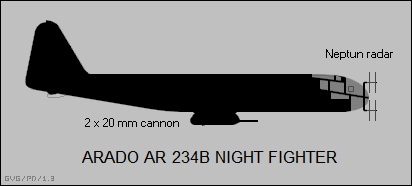
The experiments with the BMW 003 engine performed with the Ar 234 V6 and Ar 234 V8 prototypes, as well as with an Ar 234B that was fitted with the paired BMW 003 installation, also led to a next-generation variant, the "Ar 234C". The Ar 234C was powered by four BMW 003s, each rated at 7.85 kN (800 kgp / 1,760 lbf) thrust, clustered in pairs on each wing. It had a raised canopy to give a better field of view, and incorporated many small aerodynamic improvements. The result was a much faster aircraft, with a maximum speed of 870 KPH (540 MPH).
_______________________________________________________________________
ARADO AR-234C:
_______________________________________________________________________
wingspan:
14.1 meters (46 feet 4 inches)
wing area:
26.4 sq_meters (284.16 sq_feet)
length:
12.6 meters (41 feet 6 inches)
height:
4.30 meters (14 feet 1 inch)
empty weight:
5,990 kilograms (13,200 pounds)
max loaded weight:
9,890 kilograms (21,800 pounds)
maximum speed:
875 KPH (540 MPH / 470 KT)
service ceiling:
12,000 meters (39,370 feet)
operational radius:
660 kilometers (410 MI / 355 NMI)
_______________________________________________________________________
The first prototype for the Ar 234C, the "Ar 234 V19", was flown in October 1944. Once production lines were tooled, in principle all further Ar 234 production would be based on different variants of the Ar 234C. These variants included reconnaissance, bomber, night-fighter, and "general-purpose" variants, with orders in the thousands. The BMW 003 had not been refined to the point where it was very reliable, but given the military situation, it had to be used anyway.
* The failed Ardennes offensive was the very last chance the Germans had to take the initiative in the West, and from that time they were entirely on the defensive. Their defense was seriously breached on 7 March 1945, when the Americans seized the Ludendorf Bridge over the Rhine river at the town of Remagen. While German demolition specialists had attempted to destroy the bridge, it remained usable, though badly damaged. Reichsmarshal Goering ordered it to be destroyed at all costs, and over the course of the next ten days, Ar 234Bs flew several sorties in attempts to take it down. The jets failed, with losses to themselves. On 17 March, the bridge finally collapsed, but the Allies had obtained a solid foothold on the east bank of the Rhine, having built pontoon bridges to flood men and supplies into the Reich. The Western Allies were pouring into Germany at multiple locations. The end was near.
The last Ar 234s were delivered early in March. At the end of the month, demolition teams destroyed the main Arado plant to deny it to the advancing Soviets.
A total of 210 Ar 234Bs and 14 Ar 234Cs was delivered to the Luftwaffe, but with Germany in chaos, only a handful ever got into combat. A final inventory taken on 10 April 1945 listed 38 in service, including 12 bombers, 24 reconnaissance machines, and 2 night fighters. These aircraft continued to fight in a scattered and ineffective fashion until Germany surrendered on 8 May 1945. Some were shot down in air combat, destroyed by flak (sometimes their own), or bounced by Allied fighters when they came in to land. Others performed their missions and then fled too fast for enemy fighters to follow, to land and then wait for scarce fuel to be found so they could fly more missions.
BACK_TO_TOP* The end of the war terminated a number of interesting Ar 234 development efforts. A number of different variants of the Ar 234C were in the planning stage, including a two-seat night fighter. There was also design work under way for two-seat "Ar 234D" bomber and reconnaissance variants, to be powered by a pair of Heinkel-Hirth HeS 011 turbojets with 12.8 kN (1,300 kgp / 2,850 lbf) thrust each; variants with turboprop engines; and a series of "Ar 234P" three-seat night fighter variants, with a variety of different powerplant options, and Bremen centimetric radar.
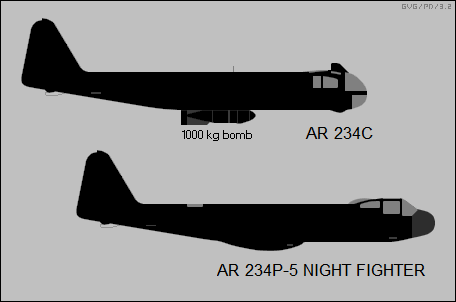
One particularly fascinating Ar 234 variant was under construction when the Allies overran the factory building it: a "crescent-wing" Ar 234, consisting of an Ar 234B fuselage mated to a concave-curved swept wing, and powered by a pair of BMW 003R combined-turbojet-rocket engines. The BMW 003R combined a turbojet with a liquid-fuel rocket that could give three minutes of enhanced power for take-off or climb. The prototype was scrapped, but the crescent-wing idea was resurrected by the British and fielded in the 1950s on the Victor V-bomber.
Another odd and dubious development was the "Deichselschlepp", or "air trailer", in which a winged fuel tank with its own undercarriage would be towed behind the Ar 234, with a tube that provided both a linkage to the trailer and a fuel feed back to the Ar 234. Plans were made to similarly tow a Fieseler Fi 103 flying bomb (better known as the V-1 buzz bomb) or a winged SC1400 bomb. In the case of the Fi 103, it was decided instead to mount the flying bomb on a cradle on the back of the Ar 234 that would hydraulically lift the aircraft above the bomber before launch. It never happened -- which was just as well, since the launch scheme sounded frighteningly hazardous.
Other "composite" schemes were considered for the Ar 234. One involved a "Mistel (Mistletoe)" configuration in which the Ar 234 carried an oversized "E.377" glide bomb under its belly, with the combination taking off on a trolley like the Ar 234 prototypes. The Ar 234 would simply point the bomb at a target and release it, with the bomb using gyrostabilization to stay on track. A more interesting scheme involved carriage of an "E.381" microfighter under the rear fuselage. The tiny E.381 accommodated a pilot lying prone and was powered by a liquid-fuel rocket engine; the Ar 234 would release the E.381 to attack a bomber formation, with the fighter then landing on a skid. Different armament configurations were considered, featuring a single 30-millimeter cannon firing over the cockpit, underwing unguided rockets, unguided rockets embedded in the wings, and so on. It had an excessively improvised and somewhat suicidal appearance.
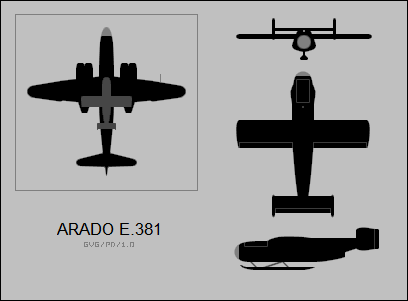
* Once the shooting stopped, a race began to collect the rewards of victory. Ar 234s were scattered all over Western Europe, and the British obtained about a dozen of them. The Soviets apparently only recovered one; for whatever reasons, the Ar 234 had been primarily used in the West.
Four Ar 234s were buttoned up with an assortment of other advanced German aircraft and shipped to the USA on the "jeep" carrier HMS REAPER. Three were given to the US Army Air Force and one to the US Navy, though the Navy's aircraft turned out to be in permanently unflyable condition. One of the three obtained by the USAAF was put through intensive tests at Wright-Patterson Air Force Base, and ultimately handed on to the Smithsonian Institution's Air & Space Museum, where it is now prominently on display. It appears to be the only Ar 234 that survives to this day.
The Ar 234 was really more of a fast strike fighter than a honest bomber, lacking a heavy warload, suited only for pinpoint attacks on well-defended targets. Too few were built for it to have much effect in that role. However, as a reconnaissance aircraft it proved able to bring back intelligence from airspace denied to prop-driven aircraft.
BACK_TO_TOP* Arado also investigated a number of new-design, swept-wing follow-ons to the Ar 234 -- but since the company was overstretched to get the Ar 234 into production, there were no resources to seriously pursue such projects. Late in the war, the company also investigated a series of larger swept-wing medium-bomber concepts under the general designation of "E.560", with a span of about 18 meters (59 feet), in contrast to the 14.1-meter (46 foot 4 inch) span of the Ar 234. Various engine and armament fits were considered, but it was far too late, and these projects were never more than pipe dreams.
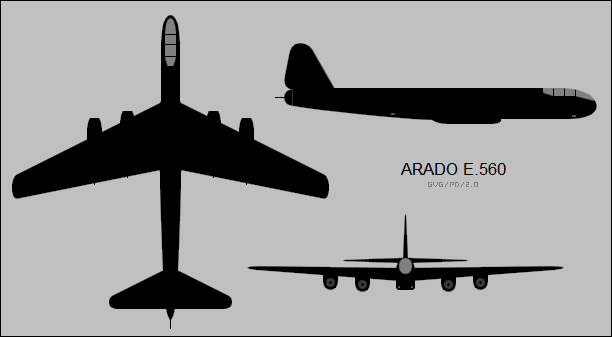
While Arado was working on the Ar 234 and considering follow-ons, other German aircraft manufacturers were developing their own jet bomber schemes. Heinkel came up with a series of concepts under the general designation of "P.1068", but in early 1944, when the military situation was beginning to look extremely grim for the German Reich, the decision was made to give up on the P.1068 concepts, and simply scale up the Ar 234 design to get an aircraft in service as fast as possible.
The result was the "He 343", which looked very much like the Ar 234 V6, with a span of 18 meters (54 feet); a mid-mounted wing; four engines, with each engine in its own nacelle; and a "bugeyed" style cockpit, something like that of a Ju 188. Various engine fits were considered, but it initially was to be powered by the Jumo 004B. Bomber and reconnaissance variants were considered, as well as a heavy interceptor, with a belly cannon tray and, somewhat oddly, a twin-cannon tail "stinger" between twin tailfins, the tail cannon being directed by periscope. Work on prototypes was in progress by the end of 1944, with some sources saying one was actually completed, but then the program was called off since the resources couldn't be spared for it. No He 343 ever flew.
The only German jet bomber besides the Ar 234 that actually more or less flew during the war was the Junkers "Ju 287". Junkers began work on a heavy jet bomber in 1943, at first focusing on a design with swept-back wings with a 25-degree sweep. However, low-speed handling appeared to be a problem with this approach, and so the design team decided to change the wings to a forward sweep.
Model tests in a wind tunnel showed that this did improve low-speed handling, but that the forward-swept wings were subjected to high levels of stress. Clearly, a proof-of-concept demonstrator needed to be flown to validate the forward-swept wing design, and so such a demonstrator was thrown together with whatever assemblies were available. The demonstrator, designated the "He 287 V1", performed its first flight on 16 August 1944. It was built around the fuselage of a Heinkel He 177A Grief heavy bomber, with the tail assembly of a Ju 388 and the new forward-swept wing. It was powered by four Junkers Jumo 004B turbojets, with one engine attached to each side of the fuselage behind the cockpit, and one engine slung under the rear of each wing.
Since the He 177's main gear retracted into its engine nacelles, which didn't exist with the new wing, the Ju 287 V1 was fitted with fixed landing gear in spats. The nose gear was salvaged from a downed American B-24 Liberator and the main gear was borrowed from a Junkers Ju 352 transport. Rauchergeraet units were used to get the contraption off the ground. It actually flew very well, though the concerns about excessive stress on the wings were justified and worrisome.
A total of 17 flights was performed with the Ju 287 V1, leading to work on a proper prototype, the "Ju 287 V2". It was to have retractable landing gear, with the nose gear retracting backwards and the main gear hinging in the wings toward the fuselage; a "bugeyed" cockpit; and was to be powered by six BMW 003A turbojets, arranged in clusters of three under each wing.
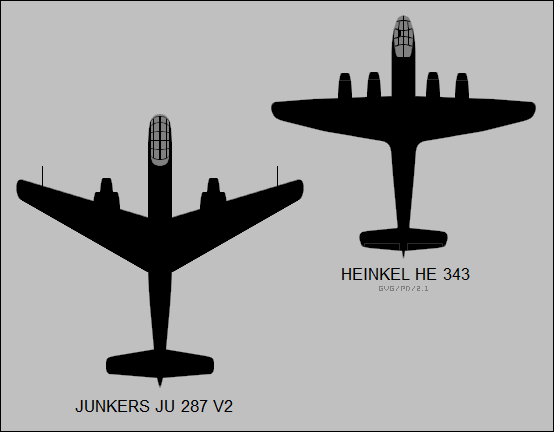
The Ju 287 V2 was unarmed. The production prototype, the "Ju 287 V3", was expected to have a 4-tonne (8,800-pound) maximum warload, and a remotely-controlled tail barbette with twin MG-131 13-millimeter machine guns, aimed through a periscopic sight.
___________________________________________________________________
JUNKERS JU 287 V3 (ESTIMATES):
___________________________________________________________________
wingspan:
20.1 meters (66 feet)
length:
18.6 meters (61 feet)
empty weight:
11,917 kilograms (26,278 pounds)
MTO weight:
21,495 kilograms (47,398 pounds)
max speed at altitude:
865 KPH (537 MPH / 467 KT)
range (max bombload):
1,585 kilometers (985 MI / 855 NMI)
___________________________________________________________________
Unsurprisingly, construction on the Ju 287 V2 prototype was abandoned in the summer of 1944, due to the dire military situation. However, the engineering team continued to play with the design, and for some bizarre reason, they were told to restart work on the prototype in early 1945. They were almost done when the Red Army arrived and spirited the prototype off to the USSR, along with most of the design team. It actually flew in 1947. The Soviets didn't put it into production, but it helped give them a long-standing interest in forward-swept wing designs, leading up to the Sukhoi S-37 Berkut experimental fighter of the 1990s.
BACK_TO_TOP* Sources for this document include:
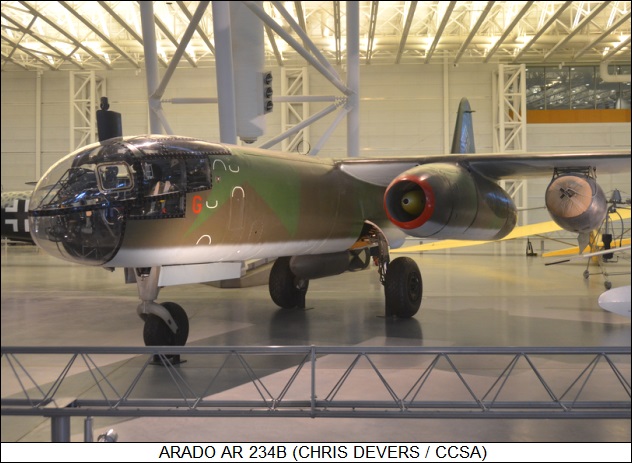
* Revision history:
v1.0 / 03 jan 97 v1.1 / 01 jun 99 / Review & polish. v1.2.0 / 01 jan 03 / Cosmetic changes, added Ju 287 data. v1.2.1 / 01 jun 04 / General illustration update, minor changes. v1.2.2 / 01 aug 06 / General illustration update, minor changes. v1.2.3 / 01 may 07 / Minor illustration changes, tweaks. v1.2.4 / 01 apr 09 / Review & polish. v1.2.5 / 01 mar 11 / Review & polish. v1.3.0 / 01 nov 11 / Rebuilt illustrations, added E.377 & E.381. v1.3.1 / 01 oct 13 / Review & polish. v1.3.2 / 01 sep 15 / Review & polish. v1.3.3 / 01 aug 17 / Review & polish. v1.3.4 / 01 jul 19 / Review & polish. v1.3.5 / 01 mar 21 / Review & polish. v1.3.6 / 01 apr 23 / Review & polish. v1.3.7 / 01 mar 25 / Review & polish.BACK_TO_TOP
